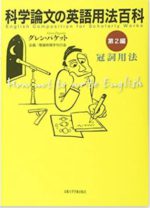グレン・パケット著『科学論文の英語用法百科』を題材に※、特許翻訳における適切な英語表現について考えていきます。※※
今回は、「categorizeとclassify」(p.167-172)について見ていきます。
1.第1編 よく誤用される単語と表現 Chapter 32 ~categorizeとclassify~
32.1 byとの誤った併用
categorizeとclassifyの誤用の中で最もよく見られるのは、byとの併用であり、この誤用は、Chapter 29(byの誤用)で詳しく解説されているように、「によって」や「で」をbyと訳してしまうことから生じている可能性があると解説されています。
ここでは、categorizeとclassifyがbyと併用された誤用例とそのリライト例が計5組紹介されており、そのうちの1組を以下に記載します。
| 誤用例[1] These vertices are categorized by their internal angles. リライト例(1) These vertices are categorized /according/with respect/ to their internal angles. |
[1]を能動態に変えると、The internal angles of these vertices categorize themになり、これは、categorizeの主語がanglesであるという不可能な状況を表現しています。一般に、categorizeまたはclassifyの主語になりうるのは、その種類を認識し、分類を決定する行為者(ほとんどの場合には人間)のみであるためです。
32.2 その他の表現との誤った併用
ここでは、categorizeとclassifyをby以外と併用した誤用例(categorized depending on, classified with, categorized in)が紹介されています。以下に"categorized depending on"の例を記載します。
| 誤用例[1] These elements are categorized depending on their orientation. リライト例(1) These elements are categorized /with respect/according/ to their orientation. |
一般に、categorizeとclassifyをdepending onと併用することはできないと解説されています。
32.3 intoとの併用により関係が不正確に描写される場合
intoをcategorizeあるいはclassifyと用いることは可能であり、正しい用法として、以下の2つが紹介されています。。
| (1) f is categorized into S. (2) The surfaces Ti are classified into the classes Σ+ and Σ-, according to the sign of their curvature at the origin. |
ここで注意すべきなのが、intoの目的語は、分類されているものが入っている類を表さなければならず、よく見られる誤用として、intoの目的語と分類されているものが同種であるか、あるいは同様な役割を果たしているという意味上の誤りによって、ありえない状況が描かれているという誤用だとされています。そのような誤用例とリライト例が計6組紹介されており、以下にそのうちの1組を記載します。
| 誤用例[3] Several distinct models on this level can be categorized into the same static O-R model. リライト例(3) Several distinct models on this level can be regarded as /corresponding to/representing/ the same static O-R model. リライト例(3*) Several distinct models on this level can be thought of as belonging to the class of a single static O-R model. |
[3]が示している関係は、static O-R modelが、models at this levelという構成要素から成る類になっているということであるところ、これは明らかに実際の関係とは異なる、と解説されています。
32.4 正しい用法
最後に、categorizeとclassifyの正しい用法が追記されています。
| (1) We categorize all the 2,148 interaction events with respect to their event topologies. (2) The eigenstates of H can be classified according to the total angular momentum, L, its z component, Lz, and one additional quantum number. (3) Otherwise, we classify such a solution as pathological. (4) We consider the parton distributions given by the two- and three-particle operators and classify them with respect to twist, spin dependence and chiral properties. (5) We classify stationary stochastic processes into two types, temporally uncorrelated and temporally correlated. |
※本記事は、著者グレン・パケット氏の許可を得て作成しています。
※※本記事は、判例(英文法だけでなく特許明細書の記載内容など様々な証拠を考慮して判断される)とは相容れない部分がある可能性があります。本記事は、純粋に英文法の側面から見た適切な英語表現を考えていくことを目的としています。
2.『科学論文の英語用法百科』について
学術論文における英作文についての解説書シリーズ。現在、「第1編 よく誤用される単語と表現」と「第2編 冠詞用法」が出版されている。
筆者は、9年間にわたって、日本人学者によって書かれた約2,000本の理工学系論文を校閲してきた。その間、「日本人の書く英語」に慣れていく中で、日本人特有の誤りが何度も論文中に繰り返されることに気付いた。誤りの頻度は、その英語についての誤解がかなり広く(場合によってほぼ普遍的に)日本人の間に浸透していることを反映しているだろう。そのような根深く定着している誤りに焦点を当て、誤りの根底にある英語についての誤解をさぐり、解説することがシリーズの基本的な方針になっている。(第1編「序文」より)
第1編 よく誤用される単語と表現
シリーズの第一巻となる本書では、日本人にとって使い方が特に理解しにくい単語や表現を扱っている。
第2編 冠詞用法
冠詞についての誤解が原因となる日本人学者の論文に見られる誤りの多さ、またその誤りに起因する意味上の問題の深刻さがゆえに、当科学英語シリーズにおいて冠詞が優先度の高いテーマとなり、この本を第二編とすることにした。(p.1)


